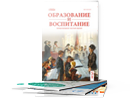The article examines the practical application of CLIL technology in English lessons for students of language specialties. An algorithm for developing professional competence is proposed, and an experiment is conducted, the purpose of which was to determine the effectiveness of the proposed algorithm and model.
Keywords : CLIL, professional competence, language specialties.
В статье рассматривается практическое применение технологии CLIL на уроках английского языка для студентов языковых специальностей. Предложен алгоритм развития профессиональной компетенции, а также проведен эксперимент, целью которого было выяснить эффективность предложенного алгоритма и модели.
Ключевые слова: CLIL, профессиональная компетенция, языковые специальности.
Research topic: «Formation of professionally oriented competence of students majoring in language specialties based on CLIL». The purpose of the research practice is to study the influence of the CLIL (Content and Language Integrated Learning) method on the formation of professional competence of students majoring in language specialties, as well as to evaluate its effectiveness in the context of integrating content and language.
The relevance of the research topic lies in the need for professional adaptation of students majoring in language specialties, future teachers and lecturers of foreign languages. The object of the research is the development of professional competence of students in the English language lesson. The subject of the research is presented by a modern methodology for the development of professional competence of students majoring in language specialties.
The objectives of this work include the following:
- To apply the CLIL teaching technology to the description of an English lesson;
- To form an understanding of this technology in students;
- To promote the development of professional competencies.
Professional competence is represented by a set of subcompetencies, both general and specific. These include: linguistic, communicative, cultural, meta-subject competencies (ability to make decisions, work in a team, analyze information and think critically), as well as information competence [1, p. 37].
Based on CLIL, students successfully master not only the language, but also academic content directly related to their future profession. Research confirms the benefits of integrated learning for mastering the target language, and also demonstrates that students studying on the basis of CLIL have a significantly higher level of foreign language proficiency than their peers who do not study on CLIL [2, p. 3].
There are various important stages in the development of professional competence of foreign language teachers [3, p. 4]. The first stage is education and training, which includes learning methods of teaching foreign languages, obtaining basic education in philology or pedagogy, and completing an internship at a school.
The second stage is professional training, which includes participating in professional development programs, learning new teaching methods and technologies, such as the use of digital resources, and mastering intercultural communication skills and the nuances of language teaching in different settings.
The third stage is practical activity, which includes teaching a foreign language in the classroom, collaborating with students of different ages and levels of preparation, creating programs and curricula, modifying resources according to student needs, and evaluating learning outcomes.
The fourth stage is reflection and self-analysis, which includes evaluating your practical activity, identifying your strengths and weaknesses, discussing your experiences with colleagues, participating in professional communities, and working on yourself and your abilities.
The fifth step is research and innovation: participating in research on teaching strategies, implementing advanced methods and technologies in the classroom, and adapting to changing student needs and the educational environment.
Last but not least is professional development, which includes long-term career and professional development planning, attending conferences and workshops, publishing research papers, and monitoring language, cultural norms, and teaching strategies.
We conducted an experiment aimed at testing the effectiveness of developing professionally oriented competence of students majoring in languages using the CLIL method.
To achieve this goal, we created the necessary pedagogical conditions, including the selection of special tasks and activities for students. These tasks allowed us to assess how effectively the chosen approach contributes to the development of professionally oriented competence. The main attention was paid to teaching methods and forms of work that serve as the basis for integrating content and language.
In the experimental group, students were presented with a specific set of tasks aimed at developing professionally oriented competence. These tasks followed a predetermined algorithm of actions, which included the transformation of information and knowledge using the appropriate language skills at each stage. The algorithm for developing professionally oriented competence includes successive stages: perception, analysis, interpretation, structuring and presentation of information.
At the perception stage, students become familiar with authentic materials related to their future profession. Particular attention is paid to capturing key terms and concepts specific to the professional field. CLIL technology emphasizes reading, especially authentic texts.
In the process of analysis and interpretation, students highlight key words and phrases, compare professional vocabulary with their native language, and analyze the contextual features of language use in a professional environment.
The information is structured using logical diagrams and tables that record the differences and similarities in terms and concepts of different cultures. The transformation of the received information into speech structures occurs through the creation of oral and written statements, the use of the studied professional vocabulary and the preparation of projects, presentations and participation in role-playing games simulating professional situations. Particular attention is paid to the use of specialized vocabulary, intonation features and stylistic techniques for effective communication in a professional environment.
Understanding of professional norms and students’ ability to apply acquired knowledge in various communicative situations are assessed. Thus, the proposed algorithm ensures consistent formation of professionally oriented competence, helping students to develop skills of analysis and interpretation of professional contexts, tolerant attitude to differences and effective adaptation to the international professional environment.
For the experiment, a model was used, which was based on the following principles: the principle of an integrated approach, the principle of practice-orientation, the principle of interdisciplinarity and the principle of continuous professional development.
The stages of the model are presented in five stages:
Stage I — the stage of activation of previous knowledge
Stage II — the stage of input of material
Stage III — emphasis on language
Stage IV — emphasis on speech
Stage V — assessment
A set of exercises has been developed for each stage.
Stage I — The Activating Stage:
- Warm-up questions: Ask students to test each other in English on their knowledge of pedagogy. “What is your favorite teaching method and why?” is one example.
- Mind maps: Place a mind map on the board so that students can write down all their pedagogical knowledge. This will help them prepare for new material and activate their existing knowledge.
- Think-pair-share: Ask students to think about what qualities a teacher should have, then discuss it with a partner and present it to the class.
Stage II — The Introductory Stage:
- Reading comprehension: Give students a text that discusses different teaching strategies. Ask them questions to assess their comprehension after they have finished reading.
- Video analysis: Show a short film about a modern teaching strategy and ask students to identify the main ideas.
- Word lists: Make a list of important words related to the subject (e.g., “differentiation,” “scaffolding,” and “formative assessment”) and help students remember them by providing definitions.
Stage III — Language Focus:
- Grammar exercises: Give students practice using tenses in a pedagogical context (e.g., “Teachers often use different strategies to engage students”).
- Sentence transformation: Have students switch between active and passive sentences using different grammatical structures.
- Role play: Students can act out scenarios in which they use certain language structures, such as when giving instructional directions.
Stage IV — Focus on Speaking:
- Facilitate a discussion on “Which teaching method is best?” Students should apply the grammar rules and vocabulary they have learned.
- Presentations: Ask students to create short presentations on different teaching philosophies and present them to the class.
- Peer teaching: Students can use English to explain specific ideas or methods to each other.
Stage V — Assessment:
- Quizzes: Give students a quick quiz on the main ideas and terms discussed in class.
- Self-assessment: Using a scale of 1 to 5, ask students to rate their ability and knowledge of the subject.
- Reflective journals: Students can write down their ideas in a journal about what they have learned and how they can use it in the future.
The entry and exit tests assessed four language skills: listening, reading, writing, and speaking. Exit test results showed improvement in all four skills, with the average score increasing by six percent.
To sum up, CLIL technology has a significant effect on the quality of education and the development of professional competence of future foreign language teachers. Studying the methodology and pedagogical content through the target language has a fruitful effect on students' academic performance and their professional training. Formation of professional competence of future foreign language teachers requires a systematic and continuous approach. An important element of education is the constant renewal and development of professional skills. In a rapidly changing world, teachers must be prepared for self-education and advanced training throughout their careers.
References:
- Jonathan, Winterton Typology of knowledge, skills and competences: clarification of the concept and prototype / Winterton Jonathan, Delamare Françoise, Stringfellow Emma. — 64. — Luxembourg: Office for Official Publications of the European Communities, 2006. — 131 c.
- Omarbekova, Gulnara. (2023). Content and Language Integrated Learning (CLIL) as an effective approach for teaching Kazakh language at the University level. 10.53057/linfo/2020.2.1.2.
- Demidova, A. (2018). Professional Competences Of A Foreign Language Teacher In Multimedia Educational Environment. 1584–1592. 10.15405/epsbs.2018.12.02.169.







